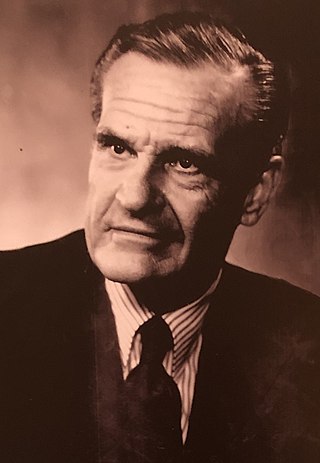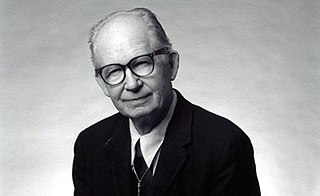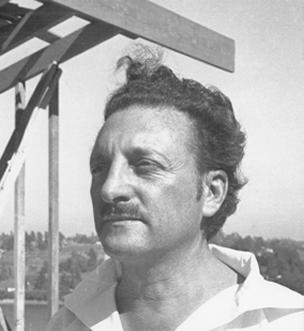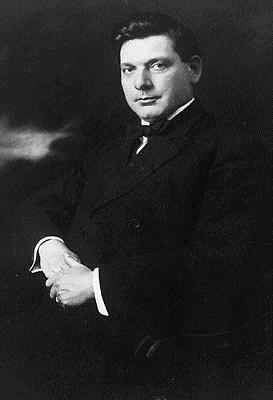Related Research Articles

Frank Lloyd Wright Sr. was an American architect, designer, writer, and educator. He designed more than 1,000 structures over a creative period of 70 years. Wright played a key role in the architectural movements of the twentieth century, influencing architects worldwide through his works and hundreds of apprentices in his Taliesin Fellowship. Wright believed in designing in harmony with humanity and the environment, a philosophy he called organic architecture. This philosophy was exemplified in Fallingwater (1935), which has been called "the best all-time work of American architecture".

William Wesley Peters was an American architect and engineer, apprentice to and protégé of his father-in-law Frank Lloyd Wright.

John Lloyd Wright was an American architect and toy inventor. Born in Oak Park, Illinois, Wright was the second-oldest son of famed architect Frank Lloyd Wright. John Lloyd Wright became estranged from his father in 1909 and subsequently left his home to join his brother on the West Coast. After unsuccessfully working a series of jobs, he decided to take up the profession of his father in 1912. Shortly afterward, he was able to reconnect with his father, who took John under his wing. Differences in opinion regarding the Imperial Hotel, Tokyo caused the pair to again become disunited.

Frank Lloyd Wright Jr., commonly known as Lloyd Wright, was an American architect, active primarily in Los Angeles and Southern California. He was a landscape architect for various Los Angeles projects (1922–1924), provided the shells for the Hollywood Bowl (1926–1928), and produced the Swedenborg Memorial Chapel at Rancho Palos Verdes, California (1946–1971). His name is frequently confused with that of his more famous father, Frank Lloyd Wright.

Rudolph Michael Schindler was an Austrian-born American architect whose most important works were built in or near Los Angeles during the early to mid-twentieth century.

Taliesin, sometimes known as Taliesin East, Taliesin Spring Green, or Taliesin North after 1937, is a historic property located 2.5 miles (4.0 km) south of the village of Spring Green, Wisconsin, United States. It was the estate of American architect Frank Lloyd Wright and an extended exemplar of the Prairie School of architecture. The expansive house-studio set on the brow of a ridge was begun in 1911; the 600-acre (240 ha) property was developed on land that previously belonged to Wright's maternal family.

Irving John Gill, was an American architect, known professionally as Irving J. Gill. He did most of his work in Southern California, especially in San Diego and Los Angeles. He is considered a pioneer of the modern movement in architecture. Twelve of his buildings throughout Southern California are listed on the National Register of Historic Places, and many others are designated as historic by local governments.
Eric Lloyd Wright was an American architect, son of Frank Lloyd Wright Jr. and the grandson of the famed Frank Lloyd Wright.
Aaron Green was an American architect and protégé of Frank Lloyd Wright.
Robert Mosher was an American architect who operated primarily in Southern California. Mosher was a Taliesin apprentice of Frank Lloyd Wright, and a pioneer of the post-war modernist architecture movement in San Diego. He is best known for designing the San Diego-Coronado Bridge, and the University of California, San Diego's John Muir College.
Kendrick Bangs Kellogg was an American architect. An innovator of organic architecture, Kellogg built a wide assortment of distinctive buildings. Homes include the Lotus House, Wingsweep, the High Desert house, and the Onion House. Public buildings include the Hoshino Wedding Chapel in Japan and Charthouse restaurants.
George Joseph Ranalli is an American modernist architect, scholar, curator, and fellow of the American Institute of Architects. He is based in New York City.

Ling Po was an artist and apprentice to Frank Lloyd Wright. Chow's English name "Ling Po" was coined by Wright by combining Chow's ancestral home Ningbo and the famous Chinese poet Li Bai.

Arthur Dyson is an American architect.
Mark Mills was an American architect who worked during the latter half of the 20th century. He apprenticed for Frank Lloyd Wright at Taliesin West from 1944–1948. Mills adapted Wright's ideas by exploring the free-form possibilities of organic design by pouring concrete into molds, a technique in construction that allows for free-form exploration. Mills is known for his use of wood, glass, and stone. Imagination aided by a background in architectural engineering allowed him to push boundaries beyond other architects of his time. His designs were guided by his desire to use local materials, recyclable manufactured pieces, and wood as close to its original form as possible.
Lois Davidson Gottlieb was an American architect best known for residential designs. She was born in San Francisco, California. Gottlieb's professional career spans more than 50 years. She practiced architecture in and outside the U.S. as a prolific residential designer. Most of her domestic designs can be found in California, Washington, Idaho and Virginia. Gottlieb's works have been featured in various publications, exhibits, and the documentary video made about her work on 'The Gottlieb House' in Fairfax Station, Virginia. Lois Davidson was an apprentice to Frank Lloyd Wright as a part of the Taliesin Fellowship in Scottsdale, Arizona, and Wright's winter home and the western counterpart to Taliesin East in Spring Green, Wisconsin, 1948–1949. Gottlieb co-founded an architectural firm, Duncombe-Davidson, with A. Jane Duncombe, who is also one of the apprentices to Wright's Taliesin at that time. Gottlieb is also a former member of International Archive of Women in Architecture's board of directors. She died on August 12, 2018, at age 91.
The 20th-Century Architecture of Frank Lloyd Wright is a UNESCO World Heritage Site consisting of a selection of eight buildings across the United States that were designed by American architect Frank Lloyd Wright. These sites demonstrate his philosophy of organic architecture, designing structures that were in harmony with humanity and its environment. Wright's work had an international influence on the development of architecture in the 20th century.
Robert Miller Green (1935–2003) was an American architect practicing for over 40 years in and around the Atlanta, Georgia area. Green studied under Frank Lloyd Wright and is best known for his residential homes and commercial projects in the style of organic architecture.

A. Jane Duncombe was born in Whitby, Ontario, Canada. She was a residential designer based in the San Francisco Bay Area some of whose architectural designs can also be found in Illinois and the rest in California. Duncombe studied at the Art Institute of Chicago School of Industrial Design and developed interest in design and architecture through her undergraduate studies. Duncombe was also one of the few female architects who became an apprentice at Frank Lloyd Wright’s Taliesin.
Tobias Guggenheimer is a Swiss-American architect, educator and author.
References
- ↑ "The New AD 100: Architectural Design's directory of Interior Designer and Architects", 2010]
- ↑ Giovannini, Joseph, and Wallace E. Cunningham. Materializing the Immaterial: The Architecture of Wallace Cunningham. New Haven, Conn: Yale University, 2006. ISBN 9780300116328
- ↑ Sutro, Dirk. West Coast Wave: New California Houses. New York: Van Nostrand Reinhold, 1994 ISBN 9780442009571
- ↑ A Gordon, "Surfing The Skyline-Pushing the Envelope of Site-Specific Design High Above San Diego", 2010
- ↑ March 22, 2009
- ↑ Anthony Walker, issue 34, Summer 2009
- ↑ The Pinnacle List "Posts tagged Wallace Cunningham"
- ↑ Jack Flemming (September 6, 2019), Alicia Keys emerges as buyer of La Jolla’s striking Razor House Los Angeles Times .